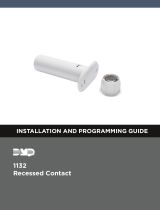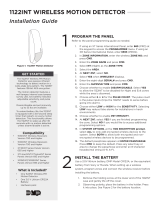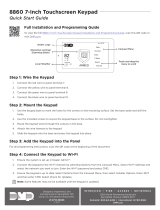Page is loading ...

1106 SERIES WIRELESS
UNIVERSAL TRANSMITTERS
Installation Guide
The 1106 Series Wireless Universal
Transmitters oer two-inputs
typically used for door and window
applications. The 1106 features built-
in optional 128-bit AES encryption.
The 1106 Series provides a cover
tamper, magnetic reed switch, and
an on-board terminal block to allow
for external contact wiring.
Both contacts, internal and external,
can be programmed to operate
at the same time. This allows two
independent zones to operate from
one 1106.
The 1106 Series also features
Disarm/Disable functionality. When
this option is set to YES, Zone
Tripped messages are disabled
when the system is disarmed to
allow for extended transmitter
battery life. Supervision, Tamper,
and Low Battery are the only
messages that are sent to the panel
when the system is disarmed.
Compatibility
What is Included?
• One 1106 Wireless Universal
Transmitter
• One magnet with standard and
commercial housing and base
• One 3.0V lithium CR123A battery
• Hardware pack
• Double-sided tape
1PROGRAM THE PANEL
Refer to the panel programming guide as needed.
1. At a keypad, enter 6653 (PROG) to access the Programmer
Menu.
2. To enable encryption, use the two steps below and then
continue to step 3. Otherwise, go to step 3.
• Navigate to System Options. At the 1100 ENCRYPTION
prompt, select ALL to only add encrypted wireless
devices to the system. Select BOTH to allow both
encyrpted and non-encrypted wireless devices to be
programmed.
• The default passphrase appears at the
ENTER PASSPHRASE prompt. Press CMD to keep the
default. Press any select key or area to change the
passphrase and enter an 8-character hexidecimal string
(0-9, A-F).
3. In ZONE INFORMATION, enter the wireless ZONE NO: and
press CMD.
4. Enter the ZONE NAME and press CMD.
5. Select the ZONE TYPE and press CMD.
6. At the NEXT ZN? prompt, select NO.
7. Select YES when WIRELESS? displays.
8. Enter the eight-digit SERIAL# and press CMD.
9. At CONTACT, select either INTERNAL or EXTERNAL.
Note: Use consecutive zone numbers if using both internal
and external contacts.
10. If EXTERNAL was chosen in Step 9, choose NO or YES at
the NORM OPEN prompt.
11. Enter the SUPRVSN TIME and press CMD.
12. At DISARM DISABLE, select NO or YES.
13. At the NEXT ZN? prompt, select YES to finish programming
or select NO for additional programming options.
2
Figure 1: 1106 Housing
INSTALL THE BATTERY
Use a 3.0V lithium battery, a DMP Model CR123 battery, or an
equivalent model from Sony or Murata. For listed installations, use
either an Energizer® 123 battery or a CR123A battery manufactured
by Panasonic or Tekcell. Keep in mind, when setting up a wireless
system, program zones and connect the wireless receiver before
installing the battery.
1. Open the 1106 by inserting a 1/4” flat head screwdriver in
the tab. See Figure 1.
2. Gently pull upwards on the screwdriver handle until the
housing completely opens.
3. Observe polarity and place the battery in the holder and
press it into place.
Tab
DESCRIPTION
All DMP XT Series and XR Series and
all 1100 Series Wireless Receivers.
To enable wireless encryption, the
following are required:
• Transmitters must have
firmware Version 201 or higher
• Panels must have firmware
Version 183 or higher
• Wireless receivers must have
firmware Version 300 or higher

2 1106 INSTALLATION GUIDE | DIGITAL MONITORING PRODUCTS
Mount the Transmitter
1. If mounting with screws, remove the battery. If mounting
with double-sided tape, place the tape on the back of the
transmitter.
2. Hold the transmitter in place with the magnetic reed
switch closest to where the magnet will be mounted. See
Figure 2. Ensure the transmitter and the magnet will be no
more than 1/2” (1.3cm) apart.
3. If using screws, place the supplied #4 screws into the two
mounting holes and secure the transmitter to the surface.
If using double-sided tape, place the transmitter on the
surface.
4. Snap the transmitter cover back onto the base.
Mount the Magnet
Standard Installation
1. Push the supplied magnet into the magnet cover.
2. Hold the magnet base on the door closest to the
magnetic reed switch, no more than 1/2” (1.3cm) from the
transmitter.
3. If using screws, use the provided #4 screws to mount the
base. See Figure 3. If using double-sided tape, place the
tape on the back of the base and place on the surface.
4. Snap the cover onto the base.
Commercial Installation
1. Push the supplied magnet into the magnet cover.
2. Place and hold the magnet cover directly on the door
closest to the magnetic reed switch, no more than 1/2”
(1.3cm) from the transmitter.
3. Use the provided #4 screws to mount the cover.
See Figure 4.
Note: Do not use double-sided tape for listed installations.
MOUNT THE 1106
For listed and commercial installations, use the supplied screws
when mounting the transmitter and the magnet.
4
Figure 3: Standard Installation
Figure 4: Commercial Installation
Wall Mount
Screw Holes
Magnetic Reed
Switch
Figure 2: Transmitter Components
3The 1106 provides a Survey LED capability to allow one person to confirm communication with the
wireless receiver or panel while the cover is removed.
1. Hold the 1106 in the exact desired location.
2. Press the tamper switch to send data to the panel and determine if communication is confirmed or
faulty.
Confirmed: If communication is confirmed, for each press or release of the tamper switch the LED
blinks immediately on and immediately o. Repeat this test to confirm five separate consecutive
LED blinks. Any indication otherwise means proper communication has not been established.
Faulty: If communication is faulty, the LED remains on for about 8 seconds or flashes multiple
times in quick succession. Relocate the 1106 or wireless receiver until the LED confirms clear
communication.
SELECT A LOCATION

1106 INSTALLATION GUIDE | DIGITAL MONITORING PRODUCTS 3
Connect External Contacts
Refer to Contacts and Zone Information in the appropriate panel programming guide for more information. DMP
recommends using 18 or 22 AWG un-shielded wire. If you use both the magnet reed switch in the 1106 transmitter
and an external contact, use consecutive zone numbers when connecting them to the panel.
1. Remove the cover of the 1106.
2. Use a flat head screwdriver to loosen the two screws on the 1106 terminal block. See Figure 5.
3. Insert the external contact wiring into the 1106 terminal block and tighten the screws.
4. Depending on how the contact was programmed in the Program the Panel section, connect the other ends
of the wires to the external contact as either normally open (N/O) or normally closed (N/C) without an end-
of-line resistor.
Figure 5: Connect External Contact
MODEL 1106
CR123
External Contact
Terminal Block
1106
Door
ADDITIONAL INFORMATION
1. Open the transmitter housing to expose the inside of the 1106. See Figure 1.
2. Remove the old battery, observe polarity, and place the new battery in the holder.
3. Snap the cover back on the 1106.
Replace the Battery
Once the battery is replaced, a sensor reset is required at the keypad to clear the LOBAT message.
1. On an LCD Keypad, press and hold 2 for two seconds. On a Graphic Touchscreen Keypad,
press RESET.
2. Enter your user code, if required. The keypad displays SENSORS OFF followed by SENSORS
ON.
Sensor Reset to Clear LOBAT
Program one
zone as an
internal contact.
EXTERNAL CONTACTS
5TEST THE 1106
After installing the 1106, perform a Wireless Check-in Test to confirm the 1106 is communicating with the
panel.
At the keypad, enter 8144 (WALK) and select WLS. If the 1106 fails to check in at the keypad, relocate the
wireless device, receiver, or panel.
When this test is initiated, the panel automatically tests the communication between itself and each wireless
zone. Wireless zones should not be manually tripped during this test. Manually tripping zones during this test
could lead to a false failure.

Designed, engineered, and
manufactured in Springfield, MO
using U.S. and global components.
LT-1377 1.01 23142
1106 SERIES WIRELESS
UNIVERSAL TRANSMITTER
Specifications
Battery
Life Expectancy 5 years
Type 3.0V lithium CR123A
Frequency Range 905-924 MHz
Color White
Housing Material Flame retardant ABS
Dimensions
Transmitter Case 1.79”L x 1.69”W x 0.84”H
Standard Magnet Housing 1.35”L x 0.38”W x 0.43”H
Commercial Magnet Housing 2.25”L x 0.38”W x 0.34”H
Patents
U.S. Patent No. 7,239,236
Ordering Information
1106-W Standard Wireless Universal Transmitter
Certifications
FCC Part 15 Registration ID: CCKPC0124
Industry Canada: 5251A-PC0124
ETL Listed
• ANSI/UL 1023 Household Burglar Alarm System
• ANSI/UL 634 Connections and Switches for use with
Burglar Alarm Systems Accessory
FCC Part 15 Registration ID: CCKPC0237
Industry Canada: 5251A-PC0237
Underwriters Laboratories
• ANSI/UL 1023 Household Burglar Alarm System
• ANSI/UL 634 Connections and Switches for use with
Burglar Alarm Systems Accessory
Note: For ANSI/UL 1023, install only on non-conductive
surfaces.
INTRUSION • FIRE • ACCESS • NETWORKS
2500 North Partnership Boulevard
Springfield, Missouri 65803-8877
800.641.4282 | DMP.com
FCC INFORMATION
This device complies with Part 15 of the FCC Rules. Operation is subject to the following two conditions:
1. This device may not cause harmful interference, and
2. this device must accept any interference received, including interference that may cause undesired operation.
The antenna used for this transmitter must be installed to provide a separation distance of at least 20 cm (7.874 in.) from all
persons. It must not be located or operated in conjunction with any other antenna or transmitter.
Changes or modifications made by the user and not expressly approved by the party responsible for compliance could void the
user’s authority to operate the equipment.
Note: This equipment has been tested and found to comply with the limits for a Class B digital device, pursuant to part 15
of the FCC Rules. These limits are designed to provide reasonable protection against harmful interference in a residential
installation. This equipment generates, uses and can radiate radio frequency energy and, if not installed and used in
accordance with the instructions, may cause harmful interference to radio communications. However, there is no
guarantee that interference will not occur in a particular installation. If this equipment does cause harmful interference to
radio or television reception, which can be determined by turning the equipment off and on, the user is encouraged to try
to correct the interference by one or more of the following measures:
1. Reorient or relocate the receiving antenna.
2. Increase the separation between the equipment and receiver.
3. Connect the equipment into an outlet on a circuit different from that to which the receiver is connected.
4. Consult the dealer or an experienced radio/TV technician for help.
INDUSTRY CANADA INFORMATION
This device complies with Industry Canada Licence-exempt RSS standards. Operation is subject to the following two
conditions:
1. This device may not cause interference, and
2. this device must accept any interference, including interference that may cause undesired operation of the device.
This system has been evaluated for RF Exposure per RSS-102 and is in compliance with the limits specified by Health Canada
Safety Code 6. The system must be installed at a minimum separation distance from the antenna to a general bystander of 7.87
inches (20 cm) to maintain compliance with the General Population limits.
Le présent appareil est conforme aux CNR d’Industrie Canada applicables aux appareils radio exempts de licence. L’exploitation
est autorisée aux deux conditions suivantes:
1. l’appareil ne doit pas produire de brouillage, et
2. l’utilisateur de l’appareil doit accepter tout brouillage radioélectrique subi, même si le brouillage est susceptible d’en
compromettre le fonctionnement.
L’exposition aux radiofréquences de ce système a été évaluée selon la norme RSS-102 et est jugée conforme aux limites établies
par le Code de sécurité 6 de Santé Canada. Le système doit être installé à une distance minimale de 7.87 pouces (20 cm)
séparant l’antenne d’une personne présente en conformité avec les limites permises d’exposition du grand public.
© 2023
/















